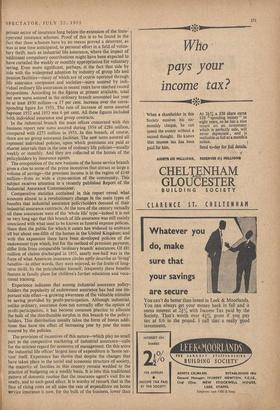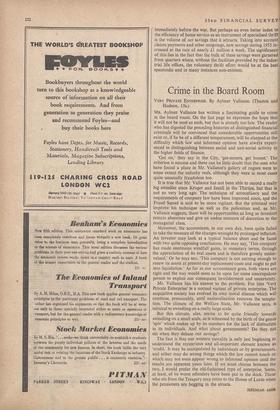Life Assurance and Thrift
By D. R. WOODGATE
A, FEW weeks ago Lord Mackintosh, Chairman of the National Savings Committee, remarked on the encourage- ment offered by some life assurance enterprises to their policyholders to invest the proceeds of endowment policies in one or another form of National Savings. Nothing could better demonstrate the complementary, rather than competitive, rela- tionship between the two very important vehicles of thrift which together contribute so large a share of the nation's reservoir of personal savings. With these one must include also the building society movement—another effective medium for more specialised forms of thrift. During a year which bids fair to establish a record for small savings, it is perhaps opportune to examine the circumstances that have influenced the expansion of one of the most progressive of thrift movements—life assurance; and in par- ticular to consider the role played by its industrial, or 'home ser- vice,' branch. It is this branch that is responsible for attracting a substantial volume of savings from a sector of the community now estimated to -embrace from ten to eleven million households.
There can be little doubt that in some respects both branches of life assurance have benefited from the prevailing 'security- consciousness' which is at once a product of the insurance in- dustry's own positive methods of salesmanship and of social and economic conditions that have established for the majority the standards of comfort, and the aspiration towards independence in old age, that were formerly the prerogative of a narrow sector of the community. Acceptance of many of the various specialised security aids associated with our present concept of the Welfare State reflected a movement of opinion that was apparent to the private sector of insurance long before the extension of the State- operated insurance schemes. Proof of this is to be found in the fact that these schemes have by no means proved a deterrent, as was at one time anticipated, to personal effort in a field of volun- tary thrift, such as industrial life assurance, where the impact of additional compulsory contributions might have been expected to have curtailed the weekly or monthly appropriation for voluntary saving. Even more significant, perhaps, is the fact that side by side with the widespread adoption by industry of group life and pension facilities—many of which are of course operated through life assurance companies and societies—sums assured by indi- vidual ordinary life assurances in recent years have reached record proportions. According to the figures at present available, total net new sums assured in the ordinary branch amounted last year to at least £930 million—a 17 per cent. increase over the corre- sponding figure for 1953. The rate of increase of sums assured between 1952 and 1953 was 6 per cent. All these figures included both individual assurance and group contracts.
In the industrial branch the main offices concerned with this business report new sums assured during 1954 of £286 million, compared with £275 million in 1953. In this branch, of course, there are no group assurance facilities. The new sums assured all represent individual policies, upon which premiums are paid at shorter intervals than in the case of ordinary life policies—usually weekly or monthly. And they arc collected at the homes of the policyholders by insurance agents.
The composition of the new business of the home service branch gives a clue to some of the prime incentives that attract so large a volume of savings—the premium income is in the region of £148 million—from so wide a cross-section of the community. This subject receives attention in a recently published Report of the Industrial Assurance Commissioner.
Comparative statistics contained in this report reveal what amounts almost to a revolutionary change in the main types of benefits that industrial assurance policyholders demand of their industrial assurance contracts. At the turn of the century virtually all these assurances were of the 'whole life' type—indeed it is not so very long ago that this branch of life assurance was still mainly associated with what used to be known as funeral expense policies. Since then the public for which it caters has widened to embrace all but about one-fifth of the homes in the United Kingdom; and with this expansion there have been developed policies of the endowment type which, but for the method of premium payment, differ little from comparable 'ordinary branch' assurances. Of £81 million of claims discharged in 1953, nearly one-half was in the form of what American insurance circles aptly describe as 'living' benefits—in other words, they were enjoyed, as the fruits of long- term thrift, by the policyholder himself; frequently these benefits feature in family plans for children's further education and voca- tional training.
Experience indicates that among industrial assurance policy- holders the popularity of endowment assurance has had one im- portant side effect—a growing awareness of the valuable stimulus to saving provided by profit-participation. Although industrial, unlike ordinary, assurance does not normally offer the option of profit-participation, it has become common practice to allocate the bulk of the distributable surplus in this branch to the policy- holders. This distribution usually takes the form of bonus addi- tions that have the effect of increasing year by year the sums assured by the policies.
The provision of incentives of this nature—which play no small part in the competitive marketing of industrial assurance—calls for the strictest regard for economy of management. On this score the industrial life offices' largest item of expenditure is 'home ser- vice' itself. Experience has shown that despite the changes that have taken place in the social and economic structure of society, the majority of families in this country remain wedded to the practice of budgeting on a weekly basis. It is into this traditional pattern of domestic routine that the insurance agent's visit fits so neatly, and to such good effect. It is worthy of remark that in the face of rising costs on all sides the rate of expenditure on home service insurance is now, for the bulk of the business, lower than
" immediately before the war. But perhaps an even better index to the efficiency of home service as an instrument of specialised thrif is the volume of net savings that it attracts. Taking into account claims payments and other outgoings, new savings during 1953 in- creased at the rate of nearly £1 million a week. The significance of this lies in the fact that the bulk of these savings were garnered from quarters where, without the facilities provided by the indus, trial life offices, the voluntary thrift effort would be at the best spasmodic and in many instances non-existent.




















































 Previous page
Previous page